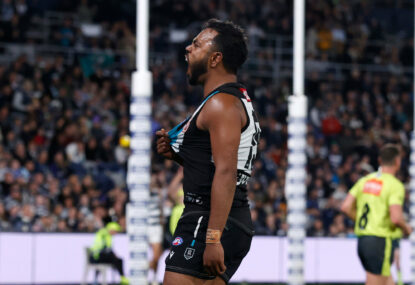Let’s get this out of the way early: the AFL is a beautiful, chaotic, breathtaking sport.
It’s a ballet of bruises, a symphony of smothers, a masterpiece of mayhem. But like any masterpiece, it needs the occasional brushstroke of refinement, and that includes introducing a send-off rule.
Yes, I said it. The AFL needs the ability to show a yellow or red card. Not for a bad haircut or a botched dribbled kick, but for those on-field acts that make us all mutter, “He shouldn’t still be out there”.
Now, before the traditionalists start throwing metaphorical meat pies at me, let’s consider both sides of the argument – and then I’ll tell you why resisting change is doing more harm than good.
There’s a certain rugged romance about footy. It’s tough, it’s physical, and players have long taken pride in walking off with a black eye and a win.
Opponents of the send-off rule argue that footy has always been a game of attrition, and part of its appeal lies in the ability to overcome adversity, even if that adversity includes being one player down because of injury or bad luck.
They’ll say we’ve got the MRO (Match Review Officer) for a reason, and that post-game suspensions serve justice just fine. They’ll point to the risk of umpires overreacting and deciding matches. And yes, nobody wants to see a Grand Final derailed because someone got red-carded for an accidental head clash. That concern is valid.
But here’s the reality: the current system is broken. Where’s the justice?
Rewinding back to Round 2, 2024. Essendon vs. Sydney. Peter Wright turns into Peter Wrong and irons out Harry Cunningham with a hit that was less “fair contest” and more “shoulder of doom.”
The result? Wright is suspended for four weeks. At the time of the incident? He’s still on the field, as if nothing happened. And the Swans? Down a man, with their rotations and structure shot to bits.
Wright plays on. Cunningham is out. Advantage: Essendon.
Or look at Round 6’s Easter Monday clash. Connor Nash hits Gryan Miers. Miers is subbed off concussed. Nash plays on.
Yes, Nash was later suspended for four games, but Geelong still lost a key player mid-match while Nash remained in the contest.
That’s not balance. That’s a system that punishes the wrong team twice.
This is where it gets a little hard to stomach. Teams are punished twice, once by the foul, and again by having to play a man down without any compensation, while the offender gallivants around like it’s just another game.
The AFL has taken great strides in recent years to protect players from concussion, late hits, and the dreaded sling tackle. But what’s the point in all this if, during the game, offenders stay on the field and victims get sent off on a stretcher?
It’s like a courtroom where the accused gets to hang around the jury while the trial’s still going. Awkward.
Remember the Western Derby in 2018? Andrew Gaff punches Andrew Brayshaw and breaks his jaw.
For the rest of the game, Gaff cops constant retaliation, including a 184kg Docker sandwich.
Gaff was the leading disposal getter that day. Yes, he was “rattled,” as coach Adam Simpson said, but he still influenced the match.
Wouldn’t it have made more sense to send him off then and there? It would have protected Brayshaw’s teammates from needing to “seek justice,” and spared Gaff from becoming the game’s moving target.
“He was rattled (during the third quarter). He was in a bit of shock, I suppose. I was just trying to put my arm around him a little bit, because it was unfortunate and we’ve got to deal with it now.” Eagles coach Adam Simpson said post-game.
For everyone’s sake, he should have been sent-off the ground. End of story.
This isn’t a call for every hard bump or mistimed tackle to be met with a red card. A send-off rule needs structure.
Maybe a yellow card for borderline acts – 15 minutes off, like the sin bin in rugby – and a red card for the truly egregious stuff: intentional hits, clear head-high contact, anything that screams “he’s done for the day and maybe a few more.”
We can give umpires the power to act when needed, but give them support too, like a review bunker.

Conor Nash looks on as Gryan Miers is seen with medical staff. (Photo by Michael Willson/AFL Photos via Getty Images)
If we can draw robotic lines to see if someone’s toe grazed the paint, we can review a hit and decide if a player should hit the showers early.
What would it solve?
– Protecting Player Welfare – if the AFL is serious about concussion and long-term health, there must be real-time consequences.
– Restoring Competitive Balance – you shouldn’t have to play a man down on the bench just because your guy got knocked out illegally.
– Discouraging Reckless Acts – nothing changes behaviour like immediate accountability. If players know they can be sent off, you’d better believe they’ll think twice.
“But it’ll ruin the game!” some might say in response. Mate, you know what ruins the game? Watching a key player go down from a hit that would make a UFC fighter wince, and knowing the offender still gets to impact the scoreboard.
The integrity of the contest should come first. A send-off rule isn’t about being soft; it’s about being fair. Hardness and fairness can and should coexist.
Let’s also not ignore the elephant in the locker room: literally every other major sport has a send-off rule.
Soccer? Red card, you’re out. Rugby? Yellow card, enjoy the naughty corner for 10 minutes; red card, off you go. Basketball? If you want to be like Draymond Green, you can spend your evening in the locker room.
The AFL is starting to look like the odd one out at the sports family dinner table, refusing to send anyone home no matter how badly they misbehave. If all these codes can manage it without spontaneous combustion, why can’t we?
What makes this even more bizarre is that the send-off rule already exists, just not at the top level. In most local and junior footy competitions, umpires have the power to red-card players for dangerous or unsportsmanlike behaviour. It’s seen as essential for protecting young athletes, maintaining fairness, and teaching respect for the game.
So why, when players get to the AFL, the pinnacle of the sport, do we suddenly decide it’s all too hard? Are we saying elite players should be less accountable than teenagers still learning how to bounce the ball?
If it works for grassroots footy, it can work at the elite level too, and arguably, it’s even more important when the stakes (and the hits) are higher.
So here we are. A sport built on pride, passion, and physicality is mature enough to say, “Yeah, sometimes someone deserves to be sent off.”
It’s not a betrayal of tradition, it’s an evolution of it. Just like we’ve embraced goal-line tech, concussion protocols, and 6-6-6 formations (well, maybe not embraced, but at least tolerated), it’s time to add the send-off rule to the mix.
Footy’s not broken. But it could use a little more balance. And if that means the occasional red card, so be it. Because when someone takes out a player with a hit that belongs in a demolition derby, we shouldn’t just send them a week’s suspension in the mail.
We should send them off. Right then and there.





































































































